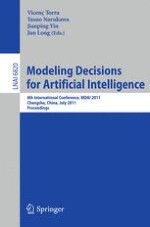2011 | Buch
Modeling Decision for Artificial Intelligence
8th International Conference, MDAI 2011, Changsha, Hunan, China, July 28-30, 2011, Proceedings
herausgegeben von: Vicenç Torra, Yasuo Narakawa, Jianping Yin, Jun Long
Verlag: Springer Berlin Heidelberg
Buchreihe : Lecture Notes in Computer Science
